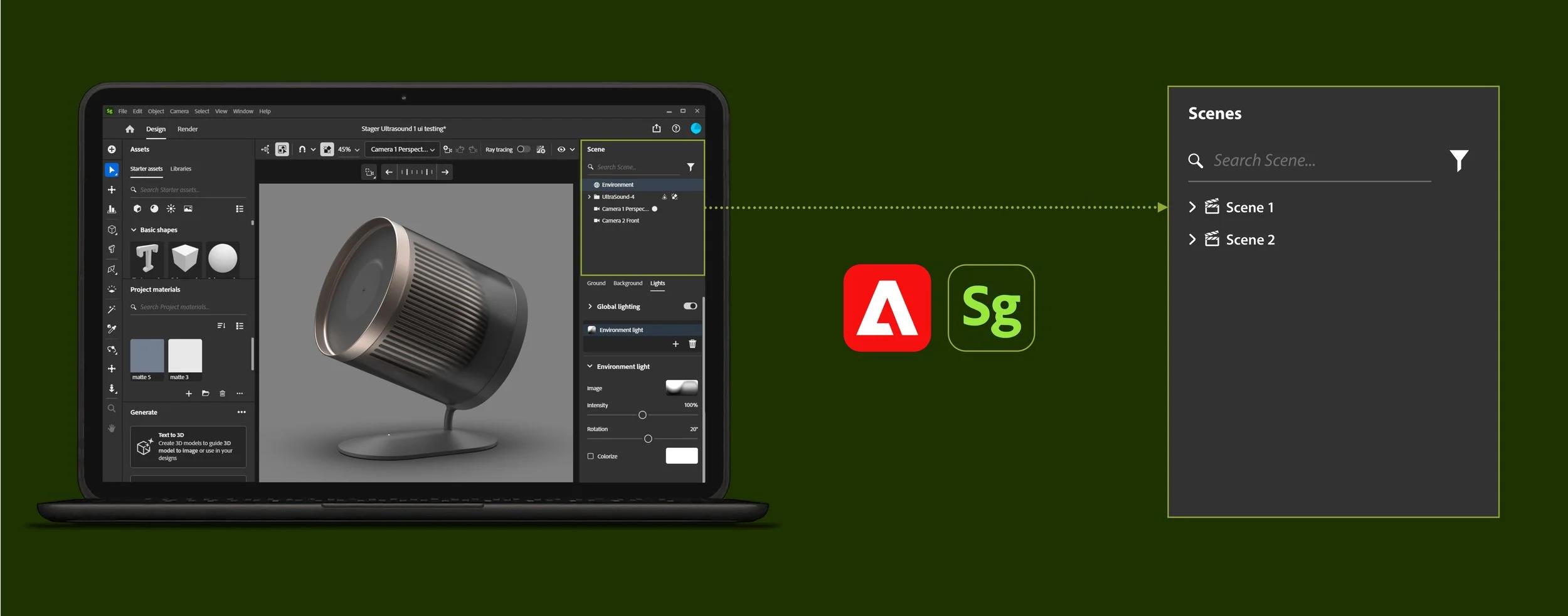GENERATIVE RESEARCH
NEW 3D CAD PRODUCT FEATURE FOR INDUSTRIAL DESIGNERS
SYNOPSIS
Define new product features that would better fit an Industrial Designer’s 3D workflow
COMPANY / CLIENT
ADOBE
CROSS FUNCTIONAL TEAMS
Product Management | Software Product Development
ROLE
Lead User Researcher
BACKGROUND
Substance 3D is a suite of 3D CAD products originally designed to facilitate Video Game Designers' workflow. Video Game Designers have adopted Substance 3D specifically its ease of use in assigning color & material (texturing) to 3D models and its robust rendering engine.
Adobe is looking to expand its Substance 3D capability to attract other 3D professionals such as Industrial Designers.
PROBLEM STATEMENTS
“How are Industrial Designers’ needs different than Game Designers’ and how can Substance 3D address them?”
CHALLENGES
“There may be pre-conceived notions regarding Industrial Designer’s 3D needs. This is especially true since Substance 3D’s original target user is Video Game Designer. ”
RESEARCH METHODOLOGY & COLLATERAL
QUALITATIVE INTERVIEW SETUP
Devising new product features suited for Industrial Designer will require both in-depth qualitative interviews and quantitative surveys. The resulting mix-method research plan is as follows:
PHASE 1
Start with Qualitative to gain insights. Resulting in
Personas | User Journeys | Identification of Product Opportunities
Deploy Quantitative Surveys to verify the qualitative findings
PHASE 2
Follow up with conducting Usability tests on hypothetical product features
*Due to the length of the overall project, this Case Study will only focus on Phase 1 Research for now.
2 Groups of users: Game Designers & Industrial Designers
Game Designer is the control group, given Substance is originally designed for Video Game Designers
6-8 participants (per designer group) spread across
Gender
Years of professional 3D CAD experience Novice | Mid | Experts
In-house design | Consultancy | Freelancers
Industry. Hard Goods vs. Soft Goods (Textile)
FINDINGS & ANALYSIS
FINDING 1
Substance Modeler’s Polygon CAD file format is not conducive to Industrial Designer’s later product manufacturing stage. Manufacturer prefer NURBS, which is better for tooling tolerance.
Substance Painter / Texturer is utilized less by Industrial Designer when compared to Video Game Designer.
ANALYSIS 1
Both the Substance Modeler Program & Texturer Program are not the best improvement opportunities for Industrial Designers.
FINDING 2
Stager is the Substance 3D Suite most widely used by Industrial Designers
Substance 3D Suite’s cost of $50/month is only 50% of the competitor’s software, Keyshot.
ANALYSIS 2
Improving Substance Stager Program is the best way to engage Industrial Designers into switching to Substance 3D suite.
FINDING 3
Stager is currently configured to allow only 1 virtual scene per file. This makes sense for Game Design since they tend to only need 1 virtual world.
Industrial Design tends to render the same product 3D model in various camera views and/or environments, all of which requires their own lighting setup.
Even Adobe Substance Community have requested this feature.
ANALYSIS 3
Stager should gain the ability to contain Multiple Scenes. Each Scene should have independent setups of:
Camera
Environmental Lighting
FINDING 4
One of Industrial Design’s biggest pain point is composing images showing Human Interaction with Products. It requires immense efforts of setup & post-editing time in Photoshop and Stager in order to composite image.
Neither Keyshot, the leading industry software, or any other software in current market is addressing this pain point.
ANALYSIS 4
Facilitating Human interaction image composition can really distinguish Substance 3D from the market. Working with the Product Manager, we identified these existing Adobe Products that can possibly be leveraged:
FIREFLY Generative Fill - Possibly generate human hands & interactions.
AR Aero + Stager incorporation - Possibly utilize human interacting with AR CAD models to achieve the same effect.
IMPACT
NEW FEATURES IDENTIFICATION
We were able to identify 2 opportunities for new feature introduction by detailing & analyzing Industrial Designer’s Workflow.
Adding the ability to set up Multiple Scenes in the same Stager File.
Explore ways to facilitate Image Composition of Human interaction with products.
Post Phase 1 Research, I worked with the Product Manager to turn the 2 main research insights into action items for the product team. Based on the require technical effort, we separated out the action items into Near-term and Long-term goals.
ACTION ITEMS
NEAR-TERM
Human Product Interaction - Image Composition
Given the bigger development effort, this will be more of a long-term goal.
The following existing Adobe Products will be a good place to start:
FIREFLY Generative Fill - Possibly generate human hands & interactions.
AR Aero + Stager incorporation - Possibly utilize human interacting with AR CAD models to achieve the same effect.
Usability Testing of Multiple Scene Feature
Will work with Product Designers to conduct usability test of different iterations of the Multiple Scene Feature.
The resulting user finding will help guide and eventual launch of the new feature.
USABILITY TESTING LINK HERE
LONG-TERM
It was hard to overcome preconceived notion that Industrial Designer’s workflow is similar to Video Game Designers. It was only after diving into nuanced details of the Industrial Designer’s workflow were we able to find the differentiation and respond with the appropriate development of the new product features.
Given multi scene feature is requested even by the General Adobe Community, this feature may be desired by user groups beyond Industrial Designers. It may be worth it to survey the general Substance 3D community to gauge interest of other user groups.
RETROSPECTIVE
Below is the project that was identified as a result of the research analysis action items.




